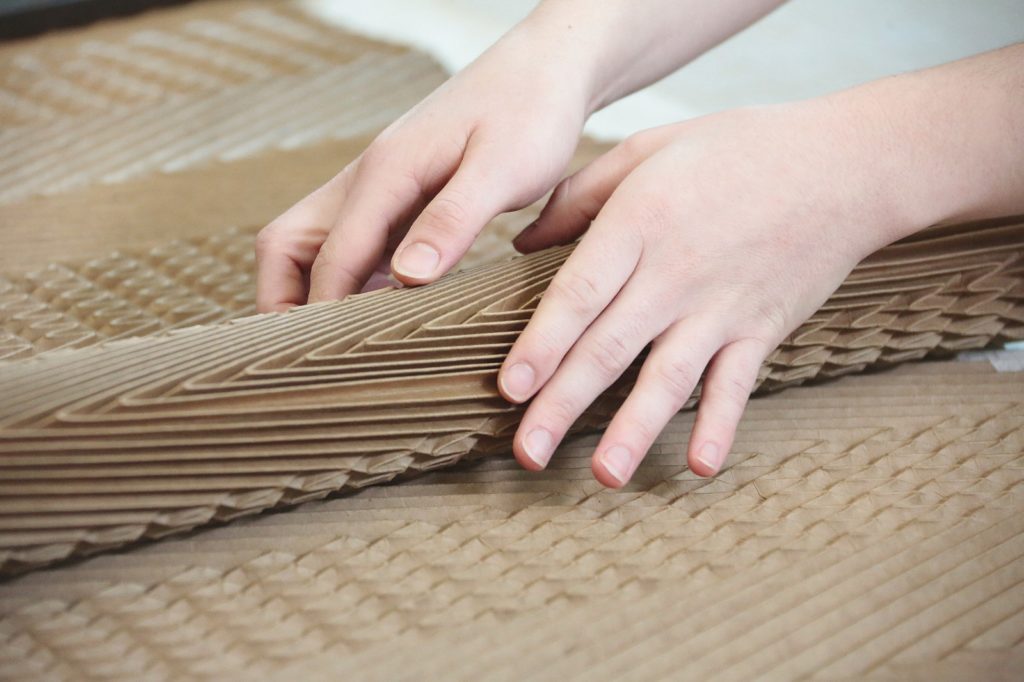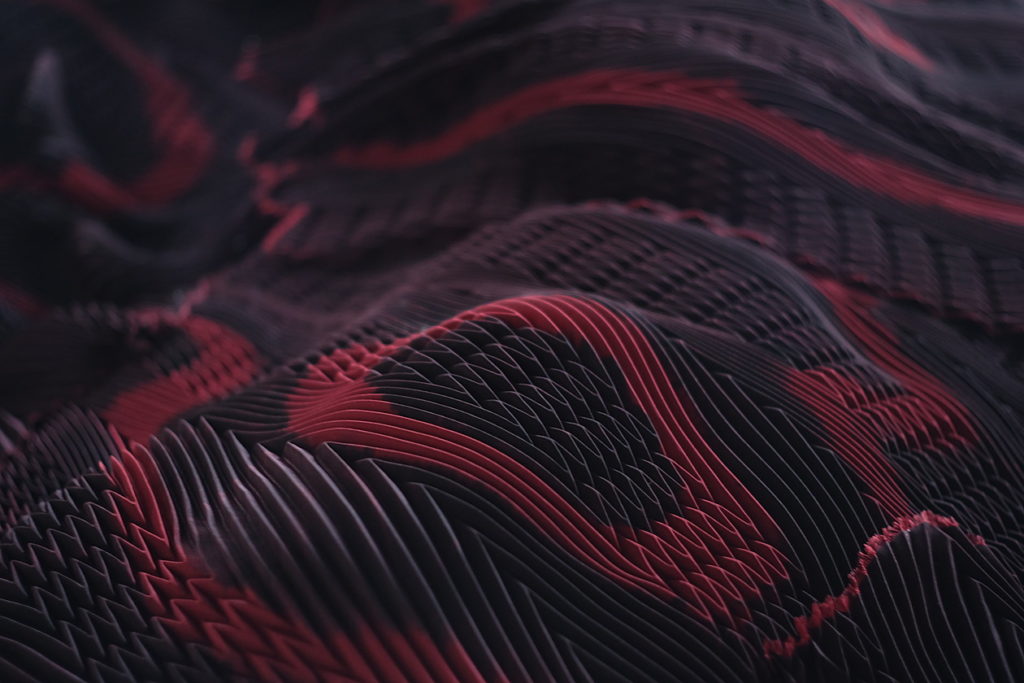
Topographie Digitale is an interactive installation created with DataPaulette collective, consisting of two parts, one physical, the other virtual. On its surface, the folds and creases extend and lengthen. The landscape formed by the pleats is joined by scarlet motifs reminiscent of level curves. The virtual entity, for its part, is video-projected and diffused through several layers of dark veiling, giving it an impression of depth. This ghostly-looking animation, composed of particles in constant movement, acts as a virtual twin to the pleated textile. This animated territory interferes with the interactions played out on the textile surface: the touch of the hand on the different zones disturbs the slow, oscillating rhythm of the animation.
Topographie Digitale est une installation interactive, créée avec le collectif DataPaulette, qui est composée de deux parties, l’une physique, l’autre, virtuelle. L’entité tangible est un paysage en volume constitué de textiles plissés. Sur sa surface, les plis et replis s’étendent et s’allongent. À ce paysage formé par les plissés viennent se joindre des motifs rouges écarlates rappelant des courbes de niveaux. L’entité virtuelle, quant à elle, est vidéo-projetée et se diffuse à travers plusieurs strates de voilages sombres qui lui donnent une impression de profondeur. Cette animation à l’apparence fantomatique, composée de particules en mouvement constant, joue le rôle de jumeau virtuel du textile plissé. Ce territoire animé répercute les interactions jouées sur la surface textile : le contact de la main sur les différentes zones va troubler le lent rythme oscillant de l’animation.

The formal choice of this installation enabled us to illustrate the principles of the meeting of different cultures, which served to create it, through a metaphor: that of the island. The physical part of the installation appears as a model of a new territory resulting from these successive exchanges. This island models the outcome of a research hypothesis, it joins other experiments in progress, and together they form an archipelago. This method of representation borrows from Édouard Glissant’s (1996) idea of archipelagic thinking, in which each production exists both independently and as part of a whole.
Le choix formel de cette installation nous a permis d’illustrer les principes de rencontre des différentes cultures, qui ont servi à sa création, par une métaphore : celle de l’île. En effet, la partie physique de l’installation apparaît comme la maquette d’un nouveau territoire issu de ces échanges successifs. Cette île modélise l’aboutissement d’une hypothèse de recherche, elle rejoint d’autres expérimentations en cours d’élaboration et forment ensemble un archipel. Cette méthode de représentation emprunte l’idée de la pensée archipélique d’Édouard Glissant (1996), faisant exister chaque production à la fois indépendamment et dans un tout.




This project is an illustration of the hybridisation between a scientific discovery and a traditional craft. In this case, we collaborated with pleating specialist Maison Lognon to investigate how to augment a textile both with new electronic functionality using in-situ polymerisation, and with new physical possibilities introduced by the patterns and textures of the pleated fabric. The pleated fabric, functionalised by this chemical treatment, and the electronic system give rise to a material with a mixed heritage, both technological and traditional, foreshadowing a potential emerging craft.
Ce projet est une illustration de l’hybridation entre une découverte scientifique et un artisanat traditionnel. Nous avons, dans ce cas, collaboré avec le spécialiste du plissage la Maison Lognon, pour étudier comment augmenter un textile à la fois par une nouvelle fonctionnalité électronique en utilisant la polymérisation in-situ, ainsi que par les nouvelles possibilités physiques introduites par les motifs et les textures du tissu plissé. Le tissu plissé, fonctionnalisé par ce traitement chimique et le système électronique donnent naissance à un matériau à l’héritage mixte, à la fois technologique et traditionnel, préfiguration d’un artisanat émergent potentiel.
Exhibitions
Intangibles Losses, part of the conference on Tangible, Embedded and Embodied Interaction (TEI) 2021, February 2021 at Art Space 5020 in Salzburg, Austria.
Ars Electronica 2020, In Kepler’s Garden, Festival for Art, Technology & Society. 9-13 Sept 2020, at JKU Campus, Linz.
De toutes façons… Design graphique et textile, from October 2019 to March 2020, at Le Signe, Centre National du Graphisme, Chaumont, France.
Awards
Nomination at STARTS Prize 2020 — STARTS (Science, Technology & the Arts) is an initiative of the European Commission, launched under the Horizon 2020 research and innovation programme. Its purpose is to support collaborations between artists, scientists, engineers and researchers to develop more creative, inclusive, and sustainable technologies.
Publications
De Bie, M., & Briot, A. (2021). Le textile électronique, un savoir-faire créole. Dans MàJ Design, environnements techniques & pratiques exploratoires (p. 29‑32). Cité du design/Esadse. Ouvrage sous la direction de Gwenaëlle Bertrand, Maxime Favard et David-Olivier Lartigaud.
Audrey Briot, Martin De Bie, Alice Giordani, Leon Denise, and Cedric Honnet. 2021. Topographie Digitale. In TEI ’21: ACM ACM International Conference on Tangible, Embedded and Embodied Interaction, Feb 14–17, 2021, Salzburg, Austria. ACM, New York, NY, USA, 4 pages. https://doi.org/10. 1145/1122445.1122456
Topographie Digitale in CyberArts 2020 Prix Ars Electronica. STARTS Prize ’20 Ed. Hannes Leopoldseder, Christine Schöpf, Gerfried Stocker, graphic design by Gerhard Kirchschläger, English, 2020. 256 pp., 500 ills. softcover, 16.50 x 24.10 cm, ISBN 978-3-7757-4761-5, p. 252
——————————————————
MIT Media Lab announcing Topographie Digitale at Ars Electronica Festival 2020.